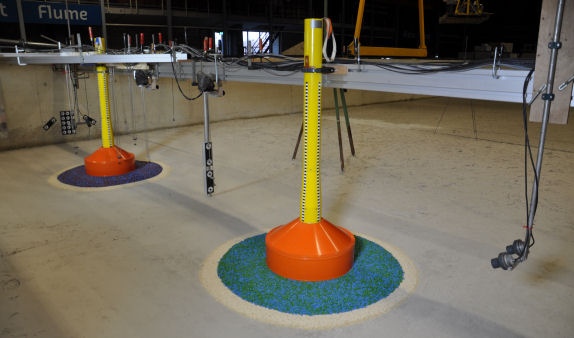A step closer to new and cheaper wind turbine foundations
A major increase in offshore wind capacity is expected in the coming years. However, because of shipping routes, oil and gas platforms, the visual impact and ecological considerations, wind farms will increasingly be located further offshore in deeper waters. The common monopiles, which are driven into the seabed, are no longer a practical option in those locations.
Gravity Based Structures (GBS) has been used for many years in the oil and gas sector and are expected to be much more suitable for deeper waters. GBS is made out of a combination of a steel pile and a concrete base that can be produced in mass production on a dedicated onshore site and floated to the wind park, where it will be submerged by adding ballast. In a joint research project with the contractors Van Oord and BAM, and the RWE energy company, Deltares looked at the practicality of this type of foundation for the offshore wind industry.

Benefits
GBS foundations have other benefits as well. Installation does not require the large and expensive crane vessels that are needed for monopiles and this represents a potential saving. In addition, the submersion approach means that installation generates almost no noise. That means there will be less underwater noise, a source of potential harm for marine mammals. As a result, installation can take place at any season, simplifying the planning process for offshore wind farms considerably.
Scour protection
In Deltares’ Atlantic Basin research was done. This research generated a lot of new knowledge. Tests showed that in the basic scour protection design, values were much too conservative. The required rock volume can be halved easily and smaller rocks can be used. As a result, these new design rules will result in major cost reductions for scour protection.
Wave loads
To refine the design even further, Deltares also investigated the wave loads on the GBS structure. On the basis of the physical tests, a range of numerical models were validated, widening the scope of applicability to different types of offshore structures.
Geotechnical load capacity
As well as the hydraulic issues, there are also interesting questions relating to the geotechnical behaviour of the subsoil. These structures are installed in shallow trenches on a filter bed and so the load capacity of the top layer of the seabed is the determining factor. Wave loads can affect this top layer and potentially cause cyclic liquefaction, leading to displacement or tilting of the foundations. To understand this process better, (partially drained) shear stress tests were conducted and a new calculation method is being developed.
FLOW
This GBS study is part of the FLOW research programme (Far and Large Offshore Wind energy, flow-offshore.nl). The programme is intended to accelerate the construction of wind farms far offshore (>50 km) by developing new, innovative technologies and carving out a leading position for Dutch companies on the international market for offshore wind farms.
You have not yet indicated whether you want to accept or reject cookies. This means that this element cannot be displayed.
Or go directly to:

